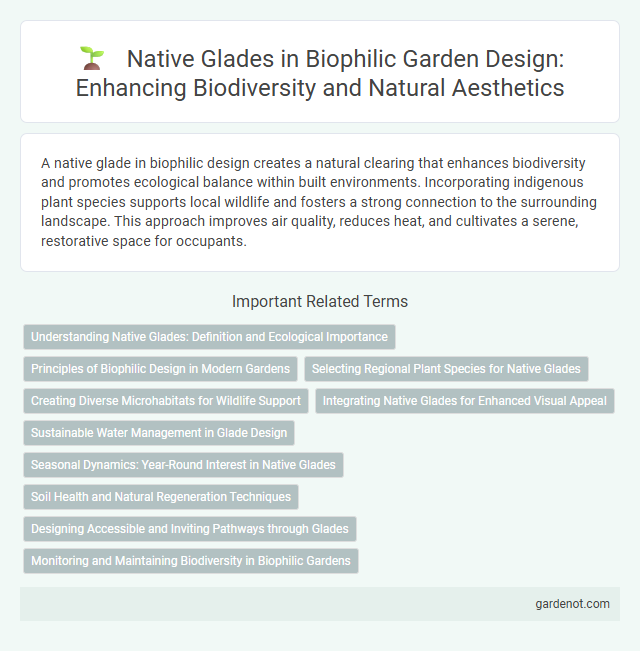A native glade in biophilic design creates a natural clearing that enhances biodiversity and promotes ecological balance within built environments. Incorporating indigenous plant species supports local wildlife and fosters a strong connection to the surrounding landscape. This approach improves air quality, reduces heat, and cultivates a serene, restorative space for occupants.
Understanding Native Glades: Definition and Ecological Importance
Native glades are naturally occurring open spaces within forests characterized by sparse tree cover and diverse herbaceous plants, playing a vital role in maintaining regional biodiversity. These ecosystems support specialized flora and fauna adapted to the unique microclimate and soil conditions, making them crucial for species conservation. Their preservation enhances ecological stability, promotes habitat connectivity, and supports pollinator populations within biophilic design landscapes.
Principles of Biophilic Design in Modern Gardens
Native glades in modern gardens embody core principles of biophilic design by integrating indigenous plant species that support local ecosystems and promote biodiversity. These naturally cleared spaces offer a sensory connection to nature through varied textures, light patterns, and seasonal changes, enhancing human well-being and environmental sustainability. Emphasizing the use of native flora aligns with biophilic strategies that foster a harmonious relationship between outdoor spaces and their natural context.
Selecting Regional Plant Species for Native Glades
Selecting regional plant species for native glades enhances ecosystem resilience and supports local wildlife by providing habitat and food sources. Using native plants reduces maintenance needs and ensures compatibility with the soil, climate, and local fauna. Emphasizing biodiversity through diverse species selection fosters ecological balance and promotes natural regeneration within biophilic design projects.
Creating Diverse Microhabitats for Wildlife Support
Native glades foster diverse microhabitats by integrating indigenous plant species that attract pollinators, birds, and small mammals, enhancing ecosystem resilience. These open, sunlit spaces within forests provide essential resources such as nectar, seeds, and shelter, promoting biodiversity in urban and suburban environments. Designing native glades informs sustainable habitat restoration and supports wildlife corridors, critical for maintaining genetic diversity and ecological balance.
Integrating Native Glades for Enhanced Visual Appeal
Integrating native glades into biophilic design enhances visual appeal by creating natural, open spaces that showcase indigenous flora and fauna. These glades promote ecological balance and support biodiversity while providing calming green areas that foster occupant well-being. Strategic placement of native glades maximizes natural light and views, reinforcing a strong connection to the local environment.
Sustainable Water Management in Glade Design
Native glade design integrates sustainable water management by utilizing native plants that optimize rainfall absorption and reduce runoff, enhancing groundwater recharge. Bioswales and permeable surfaces are strategically incorporated to filter pollutants and promote natural water cycles within the glade. This approach supports biodiversity while minimizing irrigation needs and mitigating urban heat island effects.
Seasonal Dynamics: Year-Round Interest in Native Glades
Native glades provide dynamic seasonal interest through their diverse assemblage of native grasses, wildflowers, and shrubs that change colors, textures, and blooms throughout the year. These ecosystems support local wildlife, including pollinators and migratory birds, enhancing biodiversity and ecological resilience. Thoughtful biophilic design incorporates native glades to create sustainable landscapes that shift with seasonal rhythms, promoting natural beauty and environmental health year-round.
Soil Health and Natural Regeneration Techniques
Native glades in biophilic design enhance soil health by promoting natural regeneration techniques such as fostering mycorrhizal fungi networks and encouraging native seed dispersal. These methods improve soil structure, increase microbial diversity, and boost nutrient cycling, leading to resilient ecosystems. Integrating native plant species supports long-term ecological balance and sustains natural habitat restoration.
Designing Accessible and Inviting Pathways through Glades
Designing accessible and inviting pathways through native glades emphasizes integrating natural topography and native vegetation to enhance sensory engagement and environmental comfort. Utilizing permeable materials and gentle gradients ensures inclusivity for all mobility levels while preserving indigenous flora and fauna habitats. This approach not only promotes physical accessibility but also strengthens the connection between people and the biophilic landscape.
Monitoring and Maintaining Biodiversity in Biophilic Gardens
Native glades serve as critical habitats in biophilic gardens, supporting local flora and fauna diversity by providing essential resources and shelter. Monitoring biodiversity involves regular surveys of plant species, insect populations, and bird activity to assess ecosystem health and detect changes over time. Maintaining these areas requires adaptive management practices such as controlling invasive species, promoting native plant growth, and ensuring soil and water quality to sustain ecological balance.
Native glade Infographic

 gardenot.com
gardenot.com